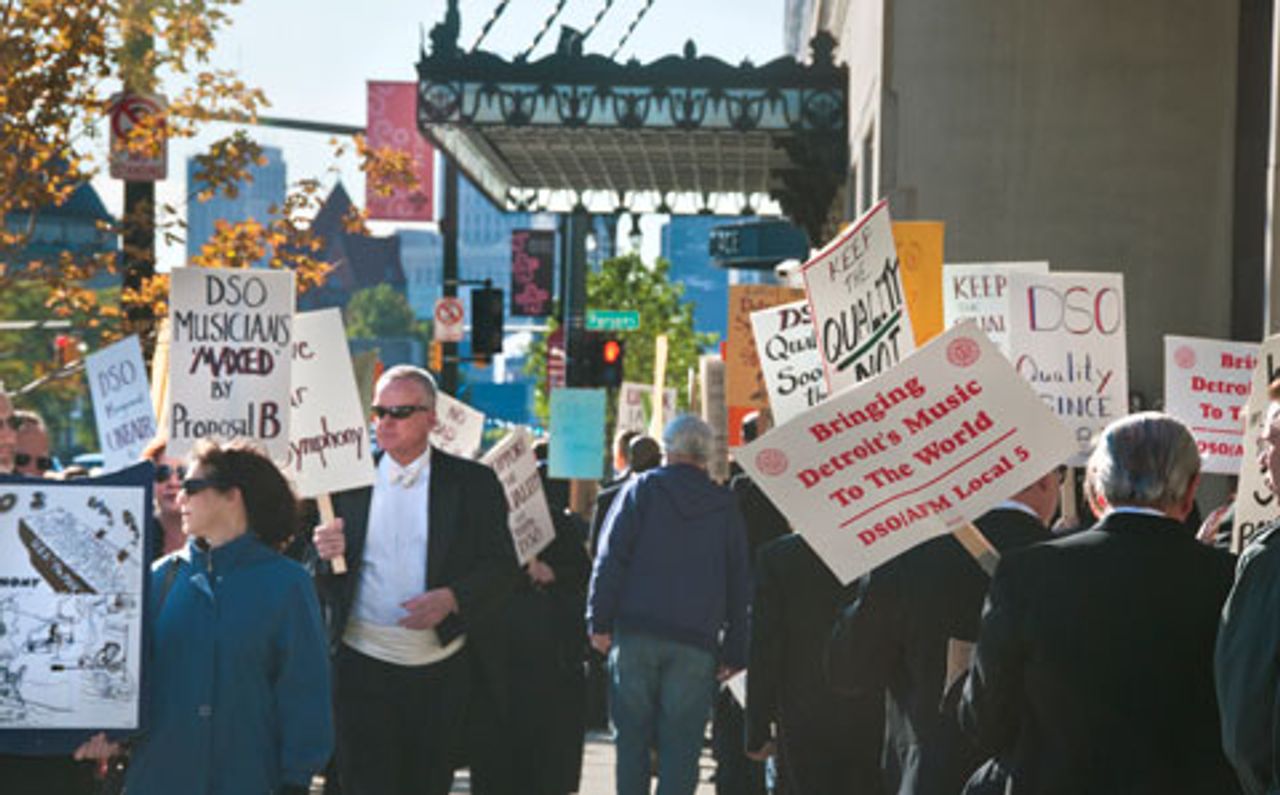Musicians of the Detroit Symphony Orchestra (DSO) returned to the concert hall April 9 after ratifying a new three year-contract, ending a six-month strike. The agreement slashed pay by some 25 percent and imposed other concessions, including a reduction in the size of the orchestra from 96 to 85 positions.
 DSO musicians picket Orchestra Hall on the first day of the strike [Photo: Hart Hollman]
DSO musicians picket Orchestra Hall on the first day of the strike [Photo: Hart Hollman]In their first concert at Orchestra Hall since before the walkout began last October, DSO musicians were greeted with a prolonged standing ovation when they came out on stage. Free tickets for the two weekend performances were gone within a matter of hours, with capacity audiences of 2,000 attending both the Saturday evening and Sunday afternoon concerts. For some in attendance it was their first classical music concert.
The huge attendance at the return concert took management by surprise. A screen was set up in the back of the hall for the overflow, and still people had to be turned away.
Conductor Leonard Slatkin led the orchestra in a performance of the “Candide” overture by Leonard Bernstein, John Williams’ “Summon the Heroes” and Samuel Barber’s “Adagio for Strings.” The concert concluded with Anton Dvorak’s Symphony No. 9. A local public television station rebroadcast the Sunday performance.
The public outpouring of support for the musicians is a sharp rebuke to management, whose campaign to vilify musicians as “overpaid” and “out of touch” fell flat. Management showed callous and reckless disregard for the impact of its actions on the orchestra, long regarded as one of the finest in the United States. It is a tribute to the resolve and solidarity of the musicians that they waged a determined resistance to this attack on culture.
That being said, the final contract is a bitter setback for musicians and will set a precedent for other orchestras. Under terms of the new agreement, starting pay for DSO musicians is reduced from $104,600 to $71,080 in the first year, with pay rising to $74,600 in the third year. The musicians defeated management demands for a two-tier pay scale and cuts in health insurance.
The new agreement contains a $198 weekly electronic media guarantee, which, when added to the base pay would bring the starting salary to about $79,000. Management had originally demanded a much larger pay cut. An optional community outreach portion would add $3,450 per year for work performed outside that required by the contract.
One veteran DSO musician told the WSWS, “The audience was glad to see us back on stage and the applause seemed to go on forever. I know there was a lot of support for us out there.”
Of the community outreach portion of the contract she added, “The extra work is all voluntary. There are two buckets. One has orchestral works. Bucket two is for musicians who wish to engage in teaching or chamber music, ad hoc things that come up. You will be offered it and you have a chance to take it.” A major point of contention had been management’s insistence on drastic changes to work rules in the name so called outreach, amounting to a demand that musicians perform unpaid services at the beck and call of management.
The strike raised a number of important issues before artists and musicians. The first is the social destructiveness of the subordination of art and culture to the profit motive. A major factor in the decision of DSO management to seek massive concessions was the pressure of major area banks, which hold some $54 million in outstanding debt on the Max M. Fisher Music Center.
Wealthy corporate executives, allies of the banks and prominent figures in the Detroit elite, dominate the DSO board of directors. The plan for drastic changes in work rules advanced by DSO management was developed by the right-wing League of American Orchestras which advocates the extension of free market principles to the world of classical music.
The strike also demonstrated the worthlessness of the official labor movement. During the course of the six-month walkout, the major unions in the area, in particular the United Auto Workers, did nothing to mobilize their membership in defense of the DSO musicians. These organizations, which themselves are involved in imposing drastic cuts in the living standards of their members viewed the determined stand of the DSO musicians with hostility and fear.
The stand of the DSO musicians once again exposed the false claim that the Democratic Party represents the interests of working people. Under the administration of former Democratic governor Jennifer Granholm, public funding for the arts was slashed to virtually zero in Michigan. Granholm and other leading Democratic Party officials never publically supported the musicians. Instead Granholm and Democratic Senator Carl Levin intervened to pressure the musicians to offer additional concessions on top of the 22 percent pay cut they had already proposed. For his part Detroit Democratic Mayor David Bing went so far as to cross the musicians’ picket line to deliver his annual state of the city address at Orchestra Hall.
That musicians did not suffer an even more severe setback is entirely due to their own efforts in mobilizing public support for their strike. The nineteen highly successful support concerts organized by the striking musician in Detroit and its suburb showed that the only constituency for the defense of art and culture is the working population.
Art and culture must be freed from its humiliating dependence on corporate and private largesse and must be made available to all. Artistic decisions must be taken out of the hands of corporate executives and placed in the hands of committees of cultural workers. To realize this program requires the independent political mobilization of the working class in the struggle for socialism.
